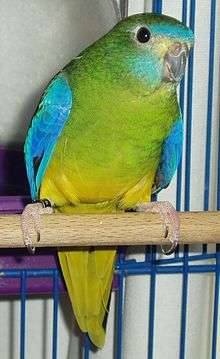Neophema
The genus Neophema is an Australian genus with six or seven species. They are small, basically dull green parrots differentiated by patches of other colours, and are commonly known as grass parrots. The genus has some sexual dichromatism, with males having brighter hues.
| Neophema | |
|---|---|
 | |
| Turquoise parrot, female | |
| Scientific classification | |
| Kingdom: | Animalia |
| Phylum: | Chordata |
| Class: | Aves |
| Order: | Psittaciformes |
| Family: | Psittaculidae |
| Tribe: | Platycercini |
| Genus: | Neophema Salvadori, 1891 |
| Species | |
|
6 or 7; see text | |
Taxonomy
Sometimes the broad-tailed parrots are considered a subfamily. In this case, Neophema and Bourke's parrot are united in the tribe Neophemini. mtDNA sequence data (Miyaki et al. 1998) suggests that the former may be correct, but the latter almost certainly is not. Rather, it appears, the group would need to include more closely related forms, such as the budgerigar and the Pezoporus ground-parrots. However, while Joseph et al. (2011) also found Neophema to be related both Bourke's parrot and ground-parrots and form part of the tribe Pezoporini, they are not related to the budgerigar.
Species
There are 6 or 7 species:
- Blue-winged parrot, Neophema chrysostoma
- Elegant parrot, Neophema elegans
- Rock parrot, Neophema petrophila
- Orange-bellied parrot, Neophema chrysogaster
- Turquoise parrot, Neophema pulchella
- Scarlet-chested parrot, Neophema splendida
Depending on the author, Neopsephotus bourkii (Bourke's parrot) may also be considered a member of this genus.
Aviculture
The scarlet-chested parrot, turquoise parrot and elegant parrot are all commonly raised and bred in captivity with a number of unusual colour forms arising. The members of this genus are not altogether easy to keep, being tender birds that may die without apparent cause, succumbing to mobbing by more robust aviary mates or diseases. This has hampered captive propagation efforts, e.g. in the case of the critically endangered orange-bellied parrot.
They are certainly not "beginner's birds" and will usually not thrive if they are not provided with a spacious aviary where a small flock can be kept in company of a few other small and harmless birds. It is possible to keep a pair or a single bird in a cage, but they will be sluggish and unhealthy if they are not let out to fly and socialize with humans frequently. Trade in wild-caught specimens is strongly restricted; in any case, these should be rejected because they are extremely tough to accustomize to aviary conditions. It is usually impossible, even for expert aviculturalists, to keep wild-caught birds alive for more than a few months. Captive-bred birds of several species are available, and these are far more hardy, though inexperienced aviculturalists should avoid them nonetheless.
Popular in Australia and internationally, Neophema are sometimes referred to as 'grass parakeets' in avicultural literature. The most easily bred are Bourke's parrot (as Neophema), scarlet-chested parrot (N. splendida), the turquoise parrot (N. pulchella), and elegant parrot (N. elegans), the most difficult and uncommon captive is the rock parrot (N. petrophila). Aside from Bourke's parrot, all are distinguished as predominantly green birds. The orange-bellied parrot has not been commercially available due to rarity and legal restriction.[1]
References
- Shephard, Mark (1989). Aviculture in Australia: Keeping and Breeding Aviary Birds. Prahran, Victoria: Black Cockatoo Press. p. 66. ISBN 978-0-9588106-0-9.
| Wikispecies has information related to Neophema |
| Wikimedia Commons has media related to Neophema. |
- Miyaki, C. Y.; Matioli, S. R.; Burke, T. & Wajntal, A. (1998): Parrot evolution and paleogeographical events: Mitochondrial DNA evidence. Molecular Biology and Evolution 15: 544–551. PDF fulltext
- Juniper & Parr (1998) Parrots: A Guide to Parrots of the World; ISBN 0-300-07453-0.